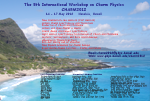Speaker
Jonna Koponen
(University of Glasgow)
Description
Chair: Jason Kumar (UH)
Abstract:
We present a new and very high statistics study of D and D_s semileptonic decay form factors on the lattice. We work with MILC N_f=2+1 lattices and use the Highly Improved Staggered Action (HISQ) for both the charm and the light valence quarks. We use both scalar and vector currents to determine the form factors f_0(q^2) and f_+(q^2) for a range of D and D_s form factors including those for D to pi and D to K semileptonic decays. By using a phased boundary condition we are able to tune accurately to q^2=0. We also compare the shape in q^2 to that from experiment, and extract the CKM matrix element |V_cs|. We show that the form factors are very insensitive to the spectator quark: D to K and D_s to eta_s form factors are essentially the same, and the same is true for D to pi and D_s to K. This has important implications when considering the corresponding B/B_s processes.
Abstract:
We present a new and very high statistics study of D and D_s semileptonic decay form factors on the lattice. We work with MILC N_f=2+1 lattices and use the Highly Improved Staggered Action (HISQ) for both the charm and the light valence quarks. We use both scalar and vector currents to determine the form factors f_0(q^2) and f_+(q^2) for a range of D and D_s form factors including those for D to pi and D to K semileptonic decays. By using a phased boundary condition we are able to tune accurately to q^2=0. We also compare the shape in q^2 to that from experiment, and extract the CKM matrix element |V_cs|. We show that the form factors are very insensitive to the spectator quark: D to K and D_s to eta_s form factors are essentially the same, and the same is true for D to pi and D_s to K. This has important implications when considering the corresponding B/B_s processes.

